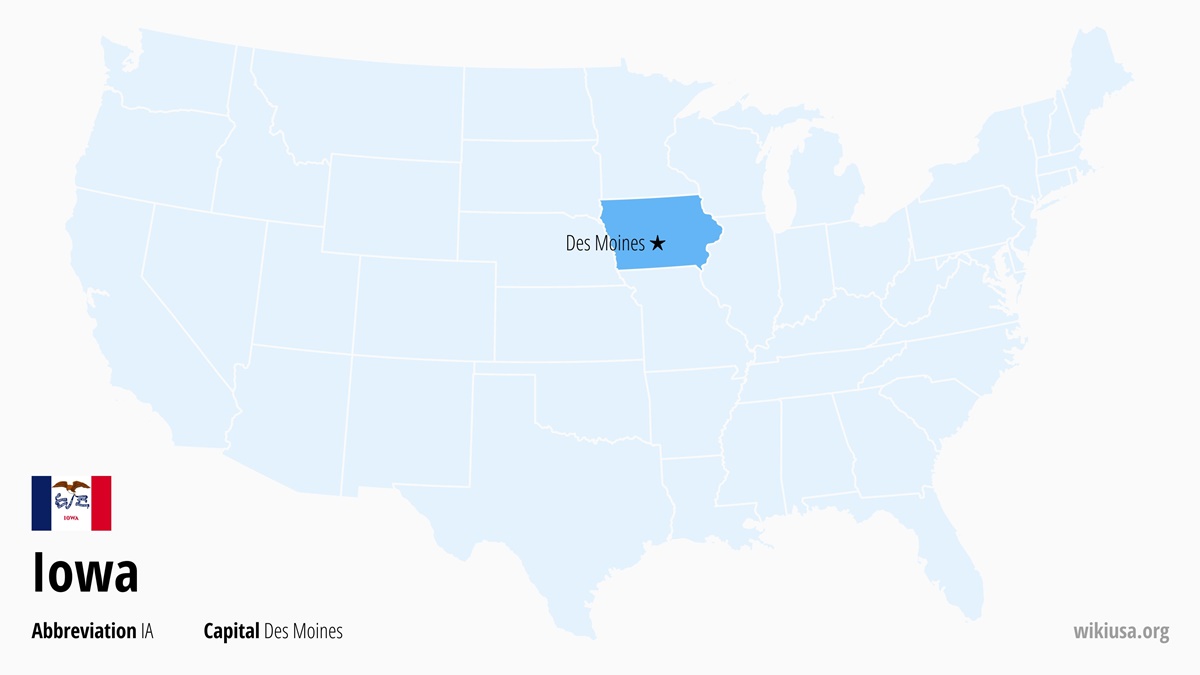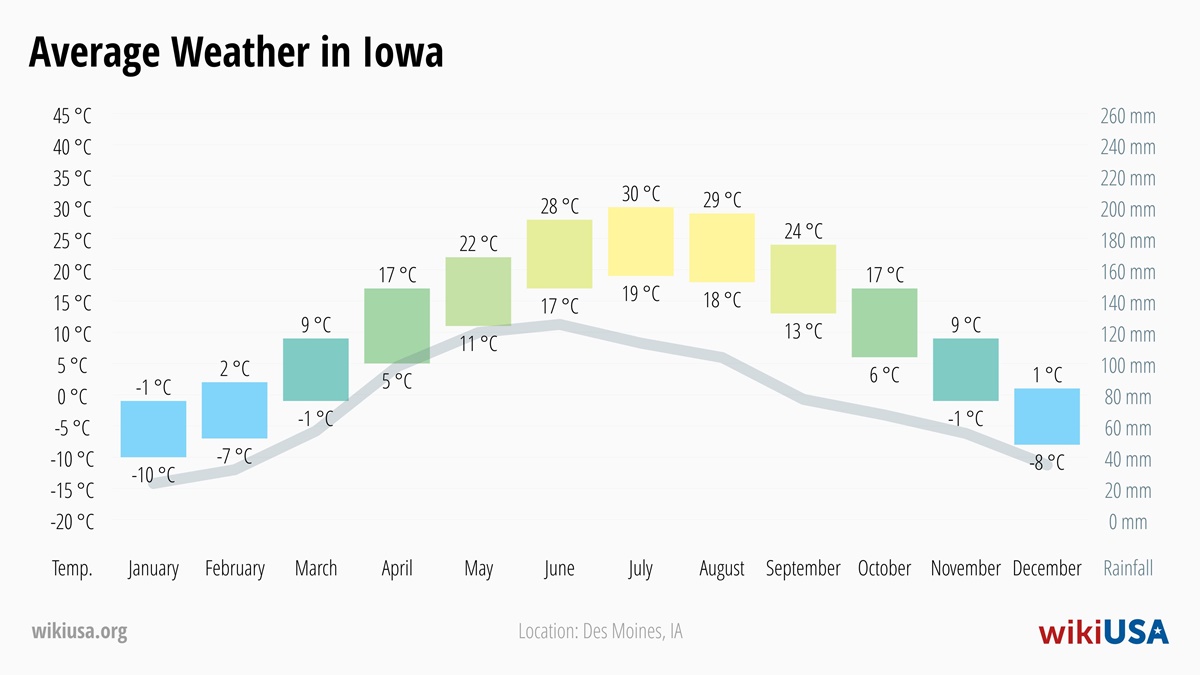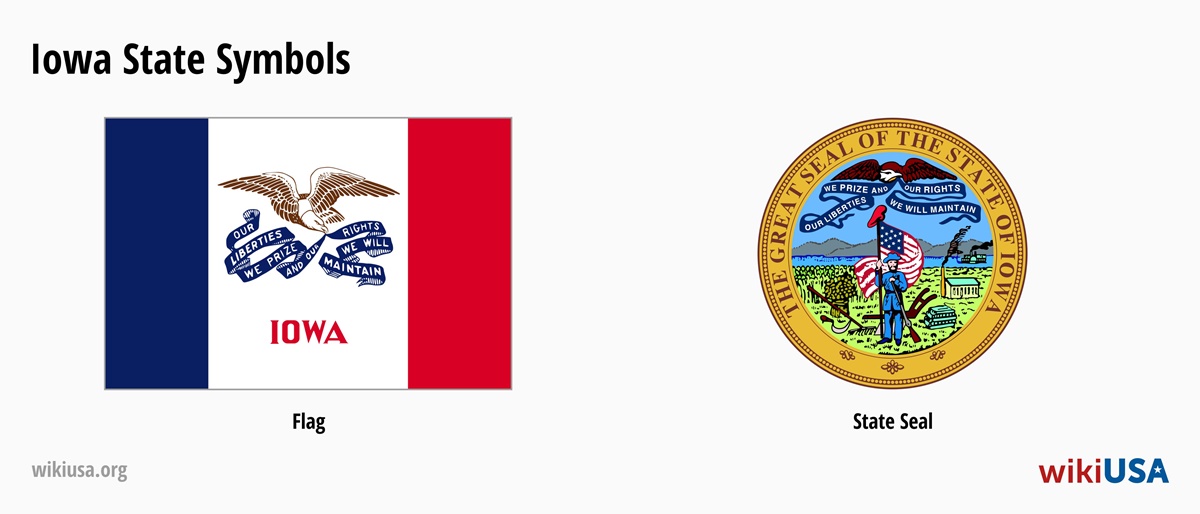Iowa (IA) is a major agricultural state in the American Midwest and one of the leading producers of corn, soybeans, and pork in the United States. The capital and largest city in Iowa is Des Moines. The state borders Minnesota, Wisconsin, Illinois, Missouri, Nebraska, and South Dakota. Until 1763, Iowa was part of a larger territory known as New France.
-
Table of Contents
Basic Information
Name Iowa Abbreviation IA Capital Des Moines Largest city Des Moines (Population: 210 381) Current time 4:53 Time zone CST (UTC-6), state observes daylight saving time CDT (UTC-5) Population 3,190,427 (#31 most populous US state) Area 56,273 sqmi (#26 largest US state) Admitted to the Union December 28, 1846 (#29 state to join) ⭐ Capital of Iowa
The capital city of the state of Iowa is Des Moines, originally established in May 1843 as a fort. The name refers to the Des Moines River, which was named by French explorers. Des Moines became the state capital in 1857.
🏙️ Largest City in Iowa
The largest city in Iowa is Des Moines, with a population of 210,381 in 2023. The second-largest city is Cedar Rapids with 135,958 residents, followed by Davenport, which has a population of 100,354.
🕒 Time in Iowa
The current time in Iowa is 4:53. The entire state follows Central Standard Time (CST, UTC-6), switching to Central Daylight Time (CDT, UTC-5) from March to November.
🧑🤝🧑 Iowa Population
According to 2023 data, Iowa had a population of 3,190,427, ranking it as the 31st most populous state in the U.S.
📍 Iowa Land Area
The total area of Iowa is 56,273 sqmi, of which 55,857 sqmi is land and only 416 sqmi is water. Iowa is the 26th largest state in the U.S.
-
Fun Facts About the State of Iowa
🧩 States Bordering Iowa
Iowa shares borders with six U.S. states: to the west is Nebraska, to the northwest South Dakota, to the north Minnesota, to the northeast Wisconsin, to the east Illinois, and to the south Missouri.
📅 Date Iowa Joined the Union
Iowa joined the Union on December 28, 1846, as the 29th state, having evolved from the original Iowa Territory.
📛 Iowa State Nickname
Since its founding, Iowa has been nicknamed “The Hawkeye State”, a reference to Chief Black Hawk of the Sauk tribe. After a failed conflict with settlers, the chief and his people were relocated to the area that is now Iowa. However, this origin story is considered a legend and should be taken with caution.
⛰️ Highest Point in Iowa
The highest point in Iowa is Hawkeye Point, which stands at 1,671 ft, located near the state’s border with Minnesota.
🏞️ Rivers in Iowa
The longest river in Iowa is the Missouri River, with a total length of 2,343 mi across all states. It is followed by the Mississippi River (2,318 mi), the Des Moines River (525 mi), the Big Sioux River (419 mi), and the Cedar River (338 mi).
🎓 Universities in Iowa
The largest university is the University of Iowa, with 30,000 students. It was founded in 1847 in Iowa City. Second is the Iowa State University, also with 30,000 students, and third is the University of Northern Iowa, with approximately 9,000 enrolled students.
✉️ ZIP Codes in Iowa
Iowa is assigned ZIP code ranges 500xx–516xx and 520xx–528xx. For more details, refer to the article ZIP Codes in the USA. To look up a ZIP code for a specific address, visit the USPS ZIP code lookup tool.
-
Weather in Iowa
The best time to visit Iowa is in the fall, when weather conditions are ideal for hiking and outdoor activities. The weather is usually stable, temperatures are mild, and precipitation levels are average or slightly lower than in other seasons.
Spring in Iowa is marked by variable weather, with frequent rain showers. April and May are typically the rainiest months, while snowfall may occur mainly in March and early April. Average temperatures range from 46 °F to 55 °F.
Summers in Iowa are traditionally very warm, with temperatures typically ranging from 73 °F to 86 °F. July and August often bring summer storms with heavy rainfall, and high humidity can create an unpleasant feeling of mugginess.
Fall in Iowa is drier and significantly cooler than summer, with temperatures generally ranging between 46 °F and 55 °F. The weather is usually stable and precipitation decreases, creating favorable conditions for hiking and nature exploration.
Winters in Iowa are very cold, with temperatures dropping to between 28 °F and 18 °F, and frequent snow showers. In December and January especially, snowfall can reach up to 30 cm per month.
🌡️ Average Temperatures and Precipitation in Iowa
-
What to See in Iowa
1️⃣ Adventureland Amusement Park
Adventureland in the city of Altoona is the largest amusement park in Iowa, offering a full day of fun for the whole family. Among more than a hundred attractions are adrenaline-pumping roller coasters, spinning rides, and attractions for younger children. A welcome refreshment during the summer months is the adjacent water park, which includes water slides and a raft ride in a man-made channel.
2️⃣ Iowa State Capitol in Des Moines
The Iowa State Capitol in Des Moines is one of the most iconic buildings in the state, thanks in large part to its gold-covered dome, which is visible from afar. Built in the Neorenaissance style between 1871 and 1886, the Capitol offers free tours of its interiors, where visitors can view historic artifacts.
3️⃣ Maquoketa Caves State Park
The main attraction of Maquoketa Caves State Park is its network of caves, accessible to both casual visitors and experienced spelunkers. The most well-known cave is Dancehall Cave, which is 800 ft long. The park features several hiking trails and also offers campgrounds and picnic areas.
4️⃣ Pikes Peak State Park
Pikes Peak State Park stretches along cliffs above the Mississippi River, offering breathtaking views. From the observation platforms, visitors can see the confluence of the Mississippi and Wisconsin Rivers. In addition to natural beauty, the park is home to ancient Native American burial mounds. The park provides excellent conditions for hiking, camping, and picnicking.
5️⃣ Boone and Scenic Valley Railroad
The historic Boone and Scenic Valley Railroad offers a unique experience aboard a steam locomotive traveling through Iowa’s scenic countryside. The highlight of the ride is crossing a 185.0 ft-high bridge over the Des Moines River. The station also features a museum that showcases the history of the railroad.
🗺️ Boone, Iowa
6️⃣ Amana Colonies
A fascinating attraction in Iowa is the historic Amana Colonies, a group of seven distinct villages founded by German immigrants in the 19th century. These settlements are known for their unique architecture and preserved traditional crafts, such as furniture making. Visitors can enjoy local cuisine at restaurants and breweries or attend a variety of festivals, including the popular Oktoberfest in October.
🗺️ Amana, Iowa
7️⃣ Loess Hills National Scenic Byway
The Loess Hills National Scenic Byway is a 220 mi long road that winds through the namesake hilly region, a favorite among photographers. Along the entire route, you’ll find scenic overlooks and hiking trails where you can stop and enjoy the beautiful landscape. Sleepy villages scattered along the byway make for interesting stops during the journey.
8️⃣ Living History Farms
Located in Urbandale, Living History Farms is an interactive museum that explores the evolution of agriculture from the 18th century to the present. In its open-air exhibits, visitors can explore replicas of historic farms and watch live demonstrations of various farming techniques. The museum’s exhibits are organized by historical periods, with distinct areas for Native American villages and industrial-era farms.
9️⃣ Iowa State Fairgrounds
For a truly unique experience, head to the Iowa State Fairgrounds in Des Moines, home to one of the largest and most well-known agricultural fairs in the United States, held annually in late summer. The fair features not only livestock shows but also concerts, competitions, and food stands. One of its most iconic traditions is the famous butter cow sculpture.
🔟 Snake Alley
Snake Alley is a relatively short street in Burlington that, when it opened in 1894, was considered the most crooked street in the world. It was later surpassed by the now-famous Lombard Street in San Francisco. Today, Snake Alley serves as a quirky tourist attraction, though it once functioned as an alternative route through the city’s hilly terrain.
-
Largest Cities in Iowa
The table shows the ten largest cities in the state of Iowa in 2023, based on data from the federal agency United States Census Bureau, whose main task is to conduct the census.
City County Population 1 Des Moines Polk, Warren 210,381 Map of Des Moines 2 Cedar Rapids Linn 135,958 Map of Cedar Rapids 3 Davenport Scott 100,354 Map of Davenport 4 Sioux City Woodbury, Plymouth 85,727 Map of Sioux City 5 Iowa City Johnson 75,678 Map of Iowa City 6 Ankeny Polk 74,458 Map of Ankeny 7 West Des Moines Polk, Dallas, Warren 72,205 Map of West Des Moines 8 Waterloo Black Hawk 66,606 Map of Waterloo 9 Ames Story 65,686 Map of Ames 10 Council Bluffs Pottawattamie 62,399 Map of Council Bluffs -
Sports Teams in Iowa
🏒 Hockey (NHL)
No NHL team is based in Iowa.
🏈 American Football (NFL)
There is no NFL team in Iowa.
🏀 Basketball (NBA)
Iowa does not have a team in the NBA.
⚾ Baseball (MLB)
There is no MLB team based in Iowa.
⚽ Soccer (MLS)
Iowa does not have a team competing in the MLS.
-
State Symbols of Iowa
Iowa has fewer official symbols codified in legislation compared to other U.S. states.
State Flag of Iowa
Iowa’s state flag resembles the French flag but differs in that the central white stripe is wider. In the center of the white field is an eagle with outstretched blue ribbons in its beak, which include the state motto. Below that is the name of the state, Iowa. The flag has been in use since March 29, 1921, and was designed by local resident Dixie Cornell Gebhardt.
Great Seal of Iowa
The Great Seal of the State was adopted in February 1847, one year after Iowa joined the Union. The central figure on the seal is a soldier standing in a wheat field, surrounded by other symbols representing agriculture, mining, and river transportation. He holds an American flag, and above him flies an eagle carrying a ribbon with Iowa’s state motto in its beak.
State Flower
The rose became an official symbol of Iowa in 1897. Although the specific variety is not defined by law, the most commonly cited type is the wild prairie rose (Rosa pratincola, which is synonymous with Rosa arkansana).
State Bird
The state bird of Iowa, designated in 1933, is the American goldfinch (Spinus tristis), which is commonly found in Iowa during the summer months and migrates south for the winter.
State Tree
In 1961, the oak tree was declared Iowa’s official state tree, without specifying any particular species.
State Song
The official state song, since March 20, 1911, is The Song of Iowa, which is set to the well-known melody of “O Tannenbaum.” The lyrics were written in 1867 by American soldier Samuel Hawkins Marshall Byers.
State Rock
In 1967, a law was passed designating the geode as Iowa’s state rock. A geode is not a specific type of stone but rather a cavity within a rock that is lined with mineral crystals. Iowa’s Geode State Park, located in the southeastern part of the state, offers an opportunity to view this type of rock formation.

 10 Best Photo Places in the USA
10 Best Photo Places in the USA







Contribute with Your Question or Personal Experience